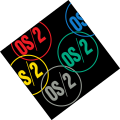 | |
 OS/2 Warp 4 desktop. This version was released on 25 September 1996.[1] | |
| Developer | IBM Microsoft (1.0–1.3) |
|---|---|
| Written in | C, C++ and assembly language |
| Working state | Historical, now developed as ArcaOS |
| Source model | Closed source |
| Initial release | December 1987 |
| Latest release | 4.52 / December 2001 |
| Marketing target | Professionals, servers |
| Available in | Chinese, English, French, German, Italian, Japanese, Korean, Spanish, Slovenian, Portuguese, Russian |
| Platforms | x86, PowerPC |
| Kernel type | Hybrid kernel |
| Influenced by | MS-DOS, IBM PC DOS |
| Default user interface | Workplace Shell |
| License | Proprietary |
| Succeeded by | eComStation ArcaOS |
| Official website | OS/2 Warp (Archived) |
OS/2 is a proprietary computer operating system for x86 and PowerPC based personal computers. It was initially created and developed jointly by IBM and Microsoft, under the leadership of IBM software designer Ed Iacobucci,[2] intended as a replacement for DOS. The first version was released in 1987; a feud between the two companies beginning in 1990 resulted in Microsoft leaving development exclusively to IBM, who continued development on their own. OS/2 Warp 4 in 1996 was the last major upgrade, after which IBM slowly halted the product as it failed to compete against Microsoft's Windows; updated versions of OS/2 were released by IBM until 2001.
The name stands for "Operating System/2", because it was introduced as part of the same generation change release as IBM's "Personal System/2 (PS/2)" line of second-generation PCs. OS/2 was intended as a protected-mode successor of PC DOS targeting the Intel 80286 processor. Notably, basic system calls were modeled after MS-DOS calls; their names even started with "Dos" and it was possible to create "Family Mode" applications – text mode applications that could work on both systems.[3] Because of this heritage, OS/2 shares similarities with Unix, Xenix, and Windows NT. OS/2 sales were largely concentrated in networked computing used by corporate professionals.
OS/2 2.0 was released in 1992 as the first 32-bit version as well as the first to be entirely developed by IBM, after Microsoft severed ties over a dispute over how to position OS/2 relative to Microsoft's new Windows 3.1 operating environment.[4][5] With OS/2 Warp 3 in 1994, IBM attempted to also target home consumers through a multi-million dollar advertising campaign.[6] However it continued to struggle in the marketplace, partly due to strategic business measures imposed by Microsoft in the industry that have been considered anti-competitive.[7][8] Following the failure of IBM's Workplace OS project, OS/2 Warp 4 became the final major release in 1996; IBM discontinued its support for OS/2 on December 31, 2006.[9] Since then, OS/2 has been developed, supported and sold by two different third-party vendors under license from IBM – first by Serenity Systems as eComStation from 2001 to 2011,[10] and later by Arca Noae LLC as ArcaOS since 2017.[11][12][13]
- ^ Matthew Nawrocki (26 February 2013). "Preview: eComStation 2.2 Beta, the legacy of OS/2 lives on". TechRepublic.com. Archived from the original on 2 September 2022. Retrieved 22 September 2013.
- ^ Nuska, Andrew (June 21, 2013). "Ed Iacobucci, co-founder of Citrix, dies of cancer". ZDNet. Archived from the original on 25 February 2023. Retrieved 20 May 2017.
- ^ Necasek, Michal (2001-09-08). "OS/2 1.3: Ten Years Ago". The History of OS/2. Archived from the original on 2007-10-12.
- ^ McCracken, Harry (2012-04-02). "25 Years of IBM's OS/2: The Strange Days and Surprising Afterlife of a Legendary Operating System". Time. ISSN 0040-781X. Archived from the original on 2022-11-28. Retrieved 2024-07-26.
- ^ Markoff, John (1992-06-28). "I.B.M. and Microsoft Settle Operating-System Feud". The New York Times. ISSN 0362-4331. Retrieved 2024-07-26.
- ^ https://www.nytimes.com/1995/08/08/science/personal-computers-os-2-no-longer-at-home-at-home.html
- ^ http://news.bbc.co.uk/1/hi/business/368660.stm
- ^ https://www.nytimes.com/1998/11/18/business/microsoft-hampered-os-2-ibm-official-tells-court.html
- ^ "Changes in support for IBM OS/2 Warp 4 and OS/2 Warp Server for e-business". IBM. 12 July 2005. Archived from the original on 27 April 2006. Retrieved 9 June 2006.
- ^ "eComStation (eCS) history". Archived from the original on 2021-02-04. Retrieved 2020-08-29.
- ^ Sanders, James (2015-11-02). "OS/2: Blue Lion to be the next distro of the 28-year-old OS". Archived from the original on 25 February 2023.
- ^ Sanders, James (2016-08-31). "OS/2 resurrected: Blue Lion becomes ArcaOS, details emerge for upcoming release". TechRepublic. Archived from the original on 25 October 2022.
- ^ Sharwood, Simon (19 May 2017). "What is dead may never die: a new version of OS/2 just arrived". The Register. Archived from the original on 19 January 2023.